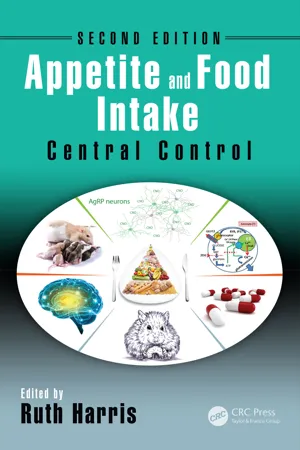
- 310 pages
- English
- ePUB (mobile friendly)
- Available on iOS & Android
About this book
Nearly half of the world's adult population is either clinically obese or overweight. Excess weight increases risk for multiple other chronic diseases and represents a major global health issue. Weight gain results from an imbalance between energy intake and expenditure, which can only be corrected if the physiologic and neuroendocrine systems that have the potential to control energy balance are identified. The first edition of this book reviewed knowledge on the intake of micro- and macronutrients, food choice, and opposing views on whether or not there are mechanisms that control food intake. Appetite and Food Intake: Central Control, Second Edition contains all new chapters and serves as a companion to the first by reviewing current knowledge on neuroendocrine mechanisms that influence food intake and glucose metabolism, including environmental influences on their development, with an emphasis on recent progress in understanding forebrain and hindbrain control of ingestive behavior.In addition, there is a discussion on the benefits derived from novel models for exploring ingestive behavior and the progress that has been achieved due to new technologies. Although major progress is being made in understanding the complex interplay between different control systems, the limits of our knowledge are acknowledged in chapters that review the efficacy of current weight control drugs and the relative importance of fat free mass and body fat in driving food intake.
Frequently asked questions
- Essential is ideal for learners and professionals who enjoy exploring a wide range of subjects. Access the Essential Library with 800,000+ trusted titles and best-sellers across business, personal growth, and the humanities. Includes unlimited reading time and Standard Read Aloud voice.
- Complete: Perfect for advanced learners and researchers needing full, unrestricted access. Unlock 1.4M+ books across hundreds of subjects, including academic and specialized titles. The Complete Plan also includes advanced features like Premium Read Aloud and Research Assistant.
Please note we cannot support devices running on iOS 13 and Android 7 or earlier. Learn more about using the app.
Information
1Appetite Control in C. elegans
1.1Introduction
1.1.1Caenorhabditis elegans Feeding
1.1.2C. elegans as a Model to Study Appetite Control
Table of contents
- Cover
- Half Title Page
- Title Page
- Copyright Page
- Contents
- Preface
- Author
- Chapter 1 Appetite Control in C. elegans
- Chapter 2 Central and Peripheral Regulation of Appetite and Food Intake in Drosophila
- Chapter 3 The Hamster as a Model for Human Ingestive Behavior
- Chapter 4 Beyond HomeostasisUnderstanding the Impact of Psychosocial Factors on Appetite Using Nonhuman Primate Models
- Chapter 5 Untangling Appetite Circuits with Optogenetics and Chemogenetics
- Chapter 6 The Use of Functional Magnetic Resonance Imaging in the Study of Appetite and Obesity
- Chapter 7 Development of Hypothalamic Circuits That Control Food Intake and Energy Balance
- Chapter 8 Maternal and Epigenetic Factors That Influence Food Intake and Energy Balance in Offspring
- Chapter 9 Monitoring and Maintenance of Brain Glucose SupplyImportance of Hindbrain Catecholamine Neurons in This Multifaceted Task
- Chapter 10 Hindbrain Astrocyte Glucodetectors and Counterregulation
- Chapter 11 Vagal Afferent Signaling and the Integration of Direct and Indirect Controls of Food Intake
- Chapter 12 Energy Metabolism and Appetite ControlSeparate Roles for Fat-Free Mass and Fat Mass in the Control of Food Intake in Humans
- Chapter 13 Pharmacotherapy for Weight Loss
- Index